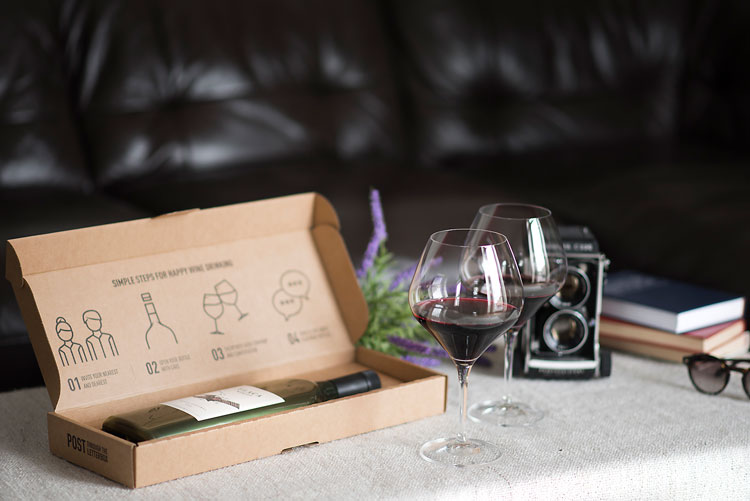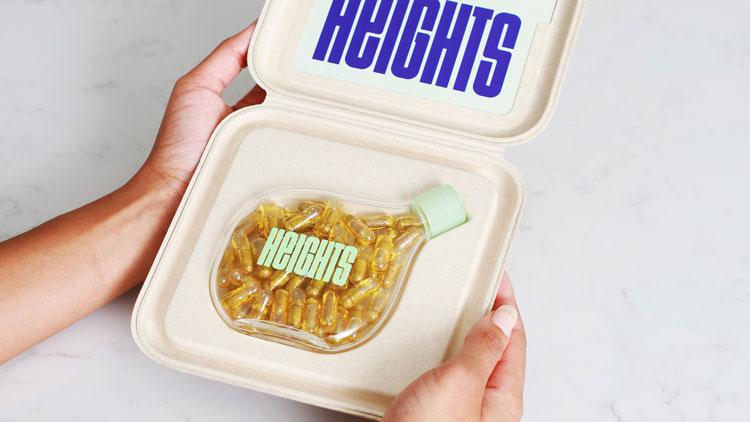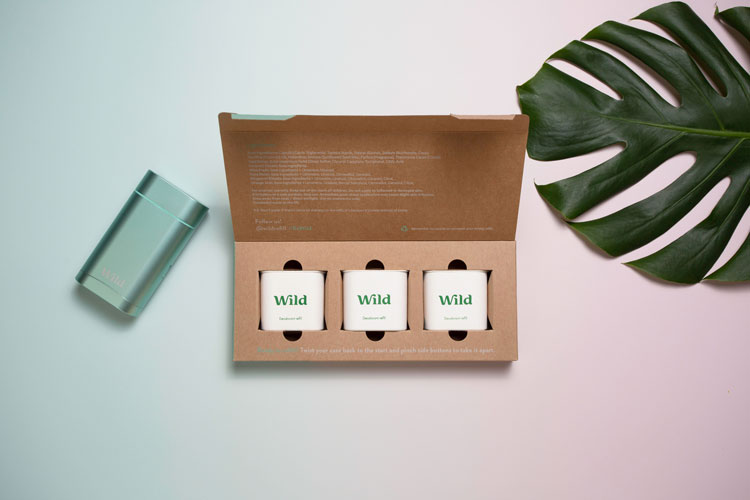Letterbox deliveries are booming. How are designers meeting these new demands?
You can get wine, laundry capsules and deodorant posted through your letterbox now, and it’s testing traditional ideas of product and packaging design.
From a distance you wouldn’t know that the Garçon wine bottle is different to any other. And that’s entirely the point, Santiago Navarro says. Garçon’s co-founder tells Design Week that when he updated the wine bottle – a design that has been around for centuries – he wanted to retain the “ceremony” of a wine bottle. How it completes a table, and the way it contributes to a meal.
But if you turn it around, you’ll see that the bottle is flat. It’s designed as a cross-section of a wine bottle; it contains the same amount of liquid, keeps the aesthetics of the neck, but has much larger surface area. It is around 40mm thick. The benefit to this, Navarro says, is that bottles can be packed like books in boxes, which reduces shipping costs. You can also post a single bottle through a letterbox (which are, on average, 45mm wide).

The design has a newfound relevance as the UK remains locked down. Online deliveries are booming; last month, one fifth of UK households ordered online. And being able to post through a letterbox means there’s no need for human contact with a postman. (In pandemic-free times, it also means you don’t have to be home to accept parcels.)
Navarro says that craft spirit makers – whose on-site business has been wiped out as restaurants and bars remain closed – have been in touch to boost their online sales. Given the current circumstances, the process of working with these companies has been “accelerated”.
“Glass is a horrible material for logistics”

Garçon Wines sells its bottles to other companies with its own curated wines, or as a private label offering. It also works with drinks brands to package their own products in the bottles. And before coronavirus impacted our retail habits, the bottle also had a sustainable angle.
It’s made from recycled polyethylene terephthalate (PET), for example. This also means it’s “rigid” enough to post through boxes and won’t shatter when it hits the ground. Glass is a “horrible material for logistics”, Navarro says. As well as the recycled material, the ability to flatpack these wine bottles means that a more sustainable supply and shipping chain is created.
One area in which glass wins is how it prevents oxygen making contact with the liquid, which makes wine go off more quickly. Navarro’s design has been treated with an “advanced barrier technology” (an additive) that keeps the wine good for 12-18 months, which is appropriate for the majority of wine that is sold in the mass market.

As well as providing a convenient logistical workaround, the bottle points to a relevant issue for the wine industry. An incredible 35 billion glass bottles are used annually in the wine industry according to Navarro, and the creation and shipping of those contributes to the climate crisis. That affects the wine industry, which is particularly vulnerable to the climate; a frost can wipe out a year of wine production. Changing how they package their product is one of the simplest things the industry could do to counter this change, Navarro says.
The future for Garçon Wines seems unusually bright right now. The London-based company now has an office in France, as well as a newly-opened one in San Francisco. Navarro says he’d like to create a bottle for carbonated drinks to tackle the beer industry’s waste problem. The company is also working on a product to package a pizza and wine bottle so that a complete meal can be posted through a door. Bloom & Wild, the flower delivery service that can also be posted through letterboxes, have teamed up with the company for a package that contains both booze and a bouquet of roses.
Small constraints, unusual design

There’s scope for designs to get even smaller though. When packages are less than 25mm, they are counted as large letters by the Royal Mail which means they fall into the cheapest delivery band. Fitting into this criteria was the incentive with Pentagram partner Jon Marshall’s design for Heights, a ‘brain health and wellness’ start-up. The brief was to create a bottle that could contain the brand’s capsules, as well as fit into this size category.
Like Navarro’s wine bottle, Marshall believes that design shouldn’t be lost because of these design constraints. If anything, it was a useful framework. “The 25mm constraint was a really great input for the project,” he tells Design Week, “and it drove much of the decision making.” “Sometimes having one really strong constraint actually helps a project,” Marshall adds.

The finished container is an asymmetric design, resembling a thought bubble. It’s transparent to show off the contents; “the capsules are transparent and quite beautiful,” the designer says. The bottle’s made from biodegradable polyactive acid (PLA). It does indeed create an unusual design, not what you would expect from a supplement brand – and importantly it provides a memorable unboxing experience for consumers.
Marshall says that the shipping box was designed in conjunction with the container and could not be made from normal cardboard as the bottle itself was almost 25mm by itself. Pentagram ended up with an “outer hinged tray” with a “moulded inner part” to keep the bottle in place. It’s made from sugar cane pulp – another nod to sustainability.

“It’s about reducing the whole product”

Another recent project that also fits through a letterbox and is classified as a large letter is Wild’s refill deodorant, designed by London-based studio Morrama. It’s the world’s first plastic-free deodorant refill, and is made from recycled bamboo pulp. Jo Barnard, the studio’s co-founder, says that the constraints “certainly help to narrow down the design options”.
And while she says it’s “very convenient to have consumable products delivered to your door”, it’s not “just about rethinking the shape to fit through a letterbox”. It is instead a chance to rethink the entire product. Barnard highlights the importance of removing water, which can reduce the weight of cleaning products by over 95% and “seems so obvious when we all have water on tap at home”.

Barnard says: “ultimately when we are a society that is increasingly shopping online, the question should always be: if it could fit through a letterbox – why doesn’t it?” She points to the need to reduce packaging, which would mean fewer pallets and delivery vehicles and a reduction in carbon dioxide emissions and cost. The studio has recently designed a coffee cup that folds down to the size of a letter – the HUNU cup – for this reason.
A “real opportunity to design disruptively”
It is not surprising that so many of these products are focused on sustainability; convenience of deliveries has not always been environmentally friendly. Every year, the Royal Mail delivers around 1.8 billion packages, which requires a large fleet of transportation vehicles. That figure doesn’t include other delivery services.
Matt Gandy, the creative director of smol, a laundry capsule delivery service says that an environmental focus drove the packaging design. The process took over a year and hundred of prototypes, Gandy says. One of the main difficulties was creating packaging that was “child impeding” as the product (liquid laundry capsules) is a potential hazard.
The packaging is plastic-free. The structural design comprises two locking tabs, which are hidden under perforated panels which can be torn off when they arrive. “By pressing the two tabs in and pushing your thumb, you unlock and slide out an inner drawer to access the capsule,” Gandy explains. That means there’s no outer shipping box, which reduces the packaging used. It’s also printed with vegetable-based inks and water-repellent coating so that it arrives “in the best possible condition”.
The brand believes it’s the world’s first plastic-free, laundry capsule packaging. This might sound like another niche category, but it’s indicative of changing retail habits, and how designers are keeping up. It might also affect other areas of design, such as branding.
As Gandy says, from a graphic design perspective, the new packaging allows a “real opportunity to design disruptively”. “Our design doesn’t need to shout for attention on the shelf,” he says. “The ‘direct to consumer’ supermarket shelf is now your social media feed.”






Found this article very relevant. During the height of the pandemic I have been doing part-time voluntary work delivering medication to local residents on behalf of my chemist. At the beginning it was straightforward as almost everyone was at home. However, in the last month or so with the easing of lockdown more and more people are going out (apart from the severely disabled or those with compromised immune systems). So I have the dilemma of whether to leave items in a ‘safe’ place or try to put medications through the letter box which vary in size according to the period of the home. Most packets of tablets can fit a standard slot but there are liquid medications in bottles that are too big (flat profile bottles would be ideal for this) plus the issue of who is on the other side of the door to pick up the packs eventually. My preference is not to break the seal on the bags containing the medication (to avoid the issue of tampering) so I have weigh up what to do with bulkier items. It works for small packs in sealed bags. Plus there are companies that have been advertising direct delivery of medications so this must be an issue they are facing.
I’m sure there was a story around mobile phone charger UK plug design perhaps ten years ago – to address this very same issue – as it was the plug size that clashed with the letterbox dimensions. After lots of investment in time and money the perfect plug and packaging was created – only to be put into a much larger box for delivery.